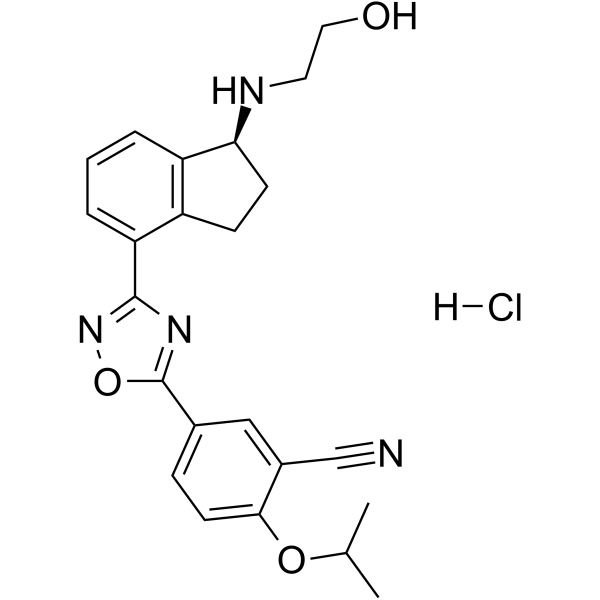| Description |
Ozanimod (hydrochloride) (RPC-1063), a sphingosine 1-phosphate (S1P) receptor modulator that binds with high affinity selectively to S1P receptor subtypes 1 (S1P1) and 5 (S1P5). Ozanimod (hydrochloride) (RPC-1063) has modulate effect for hS1P1 and hS1P5 receptor with EC50s of 1.03 nM and 8.6 nM, respectively. Ozanimod (hydrochloride) (RPC-1063) can be used for the research of relapsing multiple sclerosis (MS) [1].
|
| Related Catalog |
|
| Target |
S1PR1:1.03 nM (EC50)
S1PR5:8.6 nM (EC50)
|
| In Vitro |
Ozanimod (hydrochloride) (RPC-1063) has potency and intrinsic activity of S1P receptor modulators for S1P5 across species with [35S]-GTPgS binding, and the EC50 values of 1.03 nM, 1.29 nM, 0.90 nM, 1.02 nM and 0.61 nM for Human S1P1, Cynomolgus monkey S1P1, Mouse S1P1, Rat S1P1 and Canine S1P1, respectively; and the EC50 values of 8.6 nM, 15.9 nM, 957.5 nM, 2032.7 nM and 1662.0 nM for Human S1P5, Cynomolgus monkey S1P5, Mouse S1P5, Rat S1P5 and Canine S1P5, respectively. Ozanimod (hydrochloride) (RPC-1063) restores the potency with EC50 from 958 nM for mS1P5 to 6.7 nM for mS1P5_A120T to closely mirror the EC50 for hS1P5 of 8.6 nM by mutating the alanine in the mouse sequence. Ozanimod (hydrochloride) (RPC-1063) has binding affinity with Ki values of 2.0 nM, 59.9 nM and 5.6 nM for hS1P5, mS1P5 and mS1P5 _A120T, respectively. Ozanimod (hydrochloride) (RPC-1063) has saturation binding of [3H]-ozanimod to hS1P5, and mS1P5_A120T with KD values of 6.56 nM, 7.35 nM, respectively and also has saturation binding for [3H]-A971432 to S1P5D value of 8.75 nM[1].
|
| In Vivo |
Ozanimod (hydrochloride) (RPC-1063) (oral gavage; 0.05, 0.2, or 1 mg/kg; once daily; for 14 consecutive days) exposures sufficient to engage S1P1, but not S1P5, resulted in reduced circulating lymphocytes, disease scores, and body weight loss; reduced inflammation, demyelination, and apoptotic cell counts in the spinal cord; and reduced circulating levels of the neuronal degeneration marker, neurofilament light. Ozanimod (hydrochloride) (RPC-1063) (oral gavage; 5 mg/kg; once-daily) prevented axonal degradation and myelin loss during toxin challenge but did not facilitate enhanced remyelination after intoxication. Ozanimod (hydrochloride) (RPC-1063) (oral, 1 or 5 mg/kg, for 7 days) [1]. Animal Model: Experimental Autoimmune Encephalomyelitis Model[1] Dosage: 0.05, 0.2, or 1 mg/kg Administration: oral gavage; 0.05, 0.2, or 1 mg/kg; once daily; for 14 consecutive days Result: Attenuated body weight loss, terminal disease scores were significantly attenuated with the 0.2 and 1 mg/kg doses and ALCs were significantly reduced in all dose groups. Reduced spinal cord inflammation and demyelination, as well as attenuated the number of spinal cord apoptotic cells, and significantly reduced the levels of circulating neurofilament light at the top dose of 1 mg/kg. Animal Model: Cuprizone/Rapamycin Demyelination Model[1] Dosage: 5 mg/kg Administration: oral gavage; 5 mg/kg; once-daily Result: Protected neuronal axons, preventing breakage and ovoid formation in the corpus callosum of CPZ/Rapa treated mice. Significantly attenuated the extent to which the corpus callosum demonstrated reduced myelin content as visualized by MRI. Did not result in enhanced myelin content. Animal Model: Animal ModelC57BL/6J mice[1] Dosage: 1 or 5 mg/kg Administration: oral, 1 or 5 mg/kg, for 7 days Result: Dose Terminal body weight % versus day 1 Spinal cord inflammation Foci per 20 cells Spinal cord demyelination Score 0–5 Spinal cord apoptotic cells Count per section Plasma NfL pg/ml Vehicle (5% DMSO, 5%Tween 20, 90% water) 86.4 ± 3.2 8.50 ± 1.21 2.00 ± 0.15 2.25 ± 0.53 4.37 ± 0.89 Ozanimod (0.05 mg/kg) 85.8 ± 2.7 5.00 ± 1.03* 0.91 ± 0.21*** 1.08 ± 0.23* 3.53 ± 0.46 Ozanimod (0.2 mg/kg) 95.7 ± 3.1* 3.54 ± 0.49*** 0.73 ± 0.14 *** 0.91 ± 0.28* 2.62 ± 0.46 Ozanimod (1 mg/kg) 102.8 ± 1.8* 2.67 ± 0.56*** 0.33 ± 0.14 *** 0.60 ± 0.19** 1.91 ± 0.34**
|
| References |
[1]. Julie V Selkirk, et al. Deconstructing the Pharmacological Contribution of Sphingosine-1 Phosphate Receptors to Mouse Models of Multiple Sclerosis Using the Species Selectivity of Ozanimod, a Dual Modulator of Human Sphingosine 1-Phosphate Receptor Subtypes 1 and 5. J Pharmacol Exp Ther. 2021 Dec;379(3):386-399.
|
